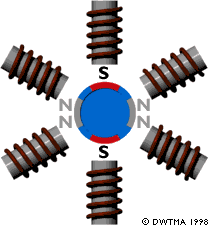Changing Generator Rotational Speed
![]()
A
Four Pole Generator

![]()
The speed of a generator (or motor) which is directly connected to a three-phase
grid is constant, and dictated by the frequency of the grid, as we learned
on the previous page.
![]() If you double the number of magnets in the stator,
however, you can ensure that the magnetic field rotates at half the speed.
If you double the number of magnets in the stator,
however, you can ensure that the magnetic field rotates at half the speed.
![]() In the picture to the left, you see how the magnetic field now moves
clockwise for half a revolution before it reaches the same magnetic
pole as before. We have simply connected the six magnets to the three phases
in a clockwise order.
In the picture to the left, you see how the magnetic field now moves
clockwise for half a revolution before it reaches the same magnetic
pole as before. We have simply connected the six magnets to the three phases
in a clockwise order.
![]() This generator (or motor) has four poles at all times, two South
and two North. Since a four pole generator will only take half a revolution
per cycle, it will obviously make 25 revolutions per second on a 50 Hz grid, or 1500 revolutions per minute
(rpm).
This generator (or motor) has four poles at all times, two South
and two North. Since a four pole generator will only take half a revolution
per cycle, it will obviously make 25 revolutions per second on a 50 Hz grid, or 1500 revolutions per minute
(rpm).
![]() When we double the number of poles in the stator of a synchronous generator
we will have to double the number of magnets in the rotor,
as you see on the picture. Otherwise the poles will not match. (We could
use to two bent "horseshoe" magnets in this case).
When we double the number of poles in the stator of a synchronous generator
we will have to double the number of magnets in the rotor,
as you see on the picture. Otherwise the poles will not match. (We could
use to two bent "horseshoe" magnets in this case).
Other
Numbers of Poles
Obviously, we could repeat what we just did, and introduce another pair
of poles, by adding 3 more electromagnets to the stator. With 9 magnets
we get a 6 pole machine, which will run at 1000 rpm on a 50 Hz grid. The
general result is the following:
Synchronous
Generator Speeds (rpm)
| Pole number | 50 Hz | 60 Hz |
| 2 | 3000 | 3600 |
| 4 | 1500 | 1800 |
| 6 | 1000 | 1200 |
| 8 | 750 | 900 |
| 10 | 600 | 720 |
| 12 | 500 | 600 |
The term "synchronous generator speed" thus refers to the speed of the generator when it is running synchronously with the grid frequency. It applies to all sorts of generators, however: In the case of asynchronous (induction) generators it is equivalent to the idle speed of the generator.
High
or Low Speed Generators?
Most wind turbines use generators with four or six poles. The reasons for
using these relatively high-speed generators are savings on size and cost.
![]() The maximum force (torque) a generator can handle depends on the rotor
volume. For a given power output you then have the choice between a slow-moving,
large (expensive) generator, or a high-speed (cheaper) smaller generator.
The maximum force (torque) a generator can handle depends on the rotor
volume. For a given power output you then have the choice between a slow-moving,
large (expensive) generator, or a high-speed (cheaper) smaller generator.
![]()
|
Back | Home | Forward |
© Copyright 1998 Soren Krohn. All rights reserved.
Updated 6 August 2000
http://www.windpower.org/tour/wtrb/genpoles.htm